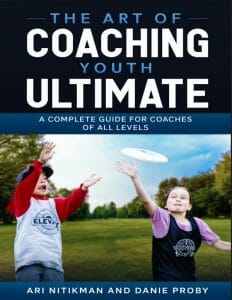Coaches can help create a positive learning environment by helping young athletes focus and removing disruptive unhealthy behaviors.
March 22, 2021 by Guest Author in Sponsored with 0 comments
The following is a preview of Elevate Ultimate‘s book, “The Art of Coaching Youth Ultimate.” If you like what you read, consider buying the kindle or paperback edition! To buy it, and for other free resources, visit their website. There have been only small modifications applied for formatting and style.
 Chapter 21 – Behavior Management
Chapter 21 – Behavior Management
I look around and all my athletes are cleated five minutes before practice starts. They seem ready to learn and listen, and are being very supportive of one another… and then I jolted up out of bed. Why can’t it be that easy? Oh right. It takes work and preparation.
This chapter is about creating the best possible environment for all of your athletes to learn. Not only will these behavior management strategies lead to your athletes becoming better ultimate players, it’s also going to save you some yelling and frustration too.
When it comes to behavior management, there are three categories we put our strategies into:
- Proactive (routines & set up to avoid the behavior altogether)
- Reactive (strategies used at practice in real-time)
- Retroactive (things done after the session is over)
Proactive Strategies
Being proactive is ideal. It will require some setup, thought, and time, especially at the beginning of your season, but it is worth it. Some strategies we have used with great success are:
1. Routines
-
- Greet your athletes as they arrive, even if it’s from far away as you’re setting up a field or a drill.
- Start with a circle to check in with the group about how they’re feeling.
- Remind them of the rules you’ve set out (this is more powerful if you’ve set the rules with your players).
- Have the athletes put the discs on the ground when you are explaining a drill or game (we can’t help spinning them around and dropping them either!).
2. Charters
-
- Create a list of actions that the team will take (facilitate this with the team).
- Create a list of consequences if people violate the team’s rules (have the team create this).
3. Design Engaging Practices (More Detail in the Practice Section)
-
- Include some new content every few practices.
- Randomly start a practice with a scrimmage.
- Avoid too much standing around and keep the kids super active.
- Put the “learning” closer to the beginning.
4. Be a Performer
-
- Change your tone and the pace of your voice, use expressions, etc.
5. Use Your Athletes
-
- For demonstrations
- To lead warm-ups
- To lead discussions and learn and teach rules
6. Build Relationships With Your Athletes
If they truly believe you care about them, their behavior will be so much better!
-
- Find out what they like outside of practice and try to connect on that topic.
- Make real eye contact.
- Try to check in with each person as an individual.
7. Praise Positive Behaviors Right Away
-
- Catch the ‘bad kid’ doing something ‘good’ early on and publicly praise them for it.
- If they think you think they’re good, they will want to be that for you.
We just threw a ton of strategies at you and we’re only going to throw more. It’s important to note that each team and coach is different and these strategies may work with varying degrees of success for different situations. Try a few and see how they go, and don’t try to implement everything all at once.
Reactive Strategies
Reactive strategies are the next line of defense. The misbehaviors can range from slightly disruptive to completely disruptive, and your strategies should suit the seriousness of the infraction.
These are some behavior strategy tools ranging from least disruptive to most disruptive:
1. Proximity Control
If you notice a couple of athletes having a quiet conversation during your explanation, just walk near them and see if that works. Remember when you were talking in class and the teacher would slowly walk over? You can also try separating people if they’re too distracting for each other.
2. Wait Time
If some athletes are talking during an explanation, stop talking and wait until they tune into the fact that you’re waiting for them. This strategy takes some time but dig in because if you don’t follow through, they will learn that you will give up. Casually staring at your watch and pretending you are bored are also ways to emphasize your point. The other athletes will notice first and give the distracted ones a little bump or a “shh” – this is good.
3. Call and Response
This one is good if it’s more than a few kids not paying attention, or if you need a quick way to get a big group to stop doing a drill. It helps if you’ve already established this, but kids are smart enough to follow along if you commit. For example, “Clap once if you can hear me,” then you clap and wait for them to clap back. “Clap twice if you can hear me,” then you clap twice and wait for them to clap twice. Usually by four everyone is tuned in.
4. Countdown of Doom
Young and old alike, as soon as someone starts a countdown, fear sinks in.
5. Individual Quiet Time
If one or two people are disrupting the group and you’re the only coach, sending someone away may be a necessary strategy (in eyesight of course). Once you sit them out, get the game/drill going and then go have a conversation with that person. Most kids know they were in the wrong so you can ask leading questions such as, “Do you know why you’re sitting out?” with great effect.
6. Group Quiet Time
You’ve lost total control of the group, oh no! It happens to the best of us. Use a sharp tone (it’s way more effective if you rarely use it, so save it if you can) and have everyone come together and sit in the circle.
Ask them questions such as, “Why are you here? What is going on? What do you want?” Let the kids wallow in the silence until they actually start to say some productive answers. Commit to the discussion if you choose this route, you don’t always need to be the “fun” coach. Follow through. Follow through. Follow through.
Retroactive Strategies
If possible, deal with behavior issues that arise with the strategies we’ve already covered. However, a call home is sometimes necessary. Calling home is the final line of defense if everything else has failed and the behavior is affecting the group negatively. Here is a quick template for that sometimes awkward call home.
- Introduce yourself.
- Ask whether “X” has had any issues lately that you need to be aware of, as their behavior has been more disruptive than usual and you wanted to check-in.
- Soften the impact by stressing their behavior has not been a huge issue and that it was unusual.
Parents will have a variety of reactions to this call. We have found that the most important part is to show that you genuinely care about their child and want to support their learning. Oftentimes, the parents know very well about their child’s behavior and are maybe embarrassed. Again, soften this moment for them. Work with them. Ask them for strategies that have worked for them. Express that you’re excited to be coaching their child. It goes a long way.
Your Turn – Manage the Situation
Scenario #1
You’re explaining the forehand to a group of athletes. There are some athletes that are proficient at throwing and some that are completely new to it. You’re the only coach, and there are 25 athletes in front of you. 4-5 of the athletes that already know how to throw forehand are being disruptive. They’re talking loudly and the other kids are super interested in what they’re saying.
What kind of archetype could these disruptors be? What kind of athletes would be exhibiting this behaviour?
List 3 proactive strategies to avoid this issue in the first place:
1.
2.
3.
List 2 reactive strategies to help the group:
1.
2
Scenario #2
You’re doing a drill that requires the athletes to run at full speed. You’ve reminded them of this a few times, but it is clear that they do not care about your request. They’re all jogging, laughing, and making fun of the activity.
What kind of archetype could these kids be? What kind of athlete would be exhibiting this behavior?
List 3 proactive strategies to avoid this issue in the first place:
1.
2.
3.
List 2 reactive strategies to help the group:
1.
2.
Did your strategies differ in the different scenarios? Did you try to start with something less invasive first and then move towards more invasive?
Just like learning a new skill, you need to practice behavior management. It’s like each bad behavior is a magical door that requires a different type of key to unlock it.
Scenario #3
Come up with one that you’ve experienced!
List 3 proactive strategies to avoid this issue in the first place:
1.
2.
3.
List 2 reactive strategies to help the group:
1.
2.
You’ve done very well so far, coach. You reflected on your coaching self and now have learned about your audience and how to manage them effectively. It’s time to move onto the pre-season planning phase.
 Chapter 21 – Behavior Management
Chapter 21 – Behavior Management